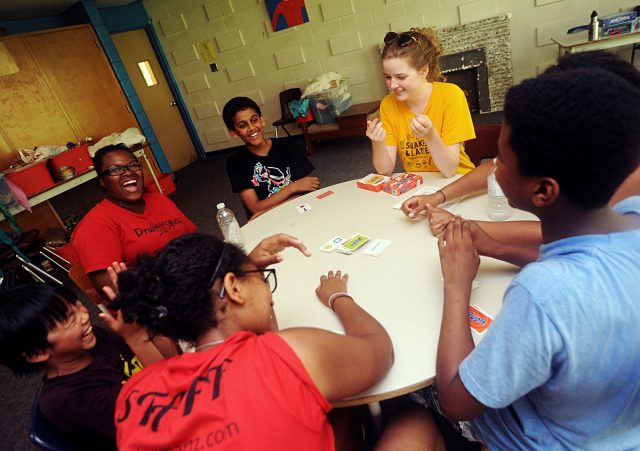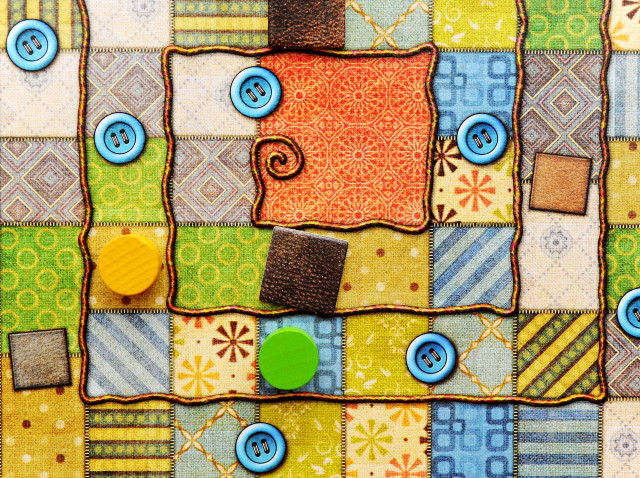I find that I am in a fairly specialized position among those I have played games with over the years: I am the eternal teacher. I’m sure I am not the only one who has inhabited this role, and it comes with a few inherent complications attached to it. To overcome those difficulties and make game nights more enjoyable for all, I have been spending the last several years practicing and refining my teaches, learning hundreds of new games, and teaching in a variety of contexts. In the following paragraphs, I will attempt to offer you some of my acquired knowledge so that you can hone your teaching muscles. My unique perspective is from years as my group’s standard teacher, and from teaching games as my profession both in a game cafe and at conventions.
Step 1: Know Your Audience
Knowing who you are talking to is the most important part about creating a cohesive teach. The way I teach a game varies hugely based on whether I’m teaching in a circle of friends, at a convention, or at a cafe. The more you know about people’s experiences, the more you can tailor the information into a context that makes sense to them. If I know you’re a big Worker Placement fan, I don’t need to teach that concept while I teach Everdell.
Step 2: Goal and Ending

Your players are already going to have a preconceived notion of the game, whether they know anything about it or not. Usually, they will at least come into the explanation believing that they want to win, and usually they are right about that. It helps to give information that fuses with what the players already know. Tell them how to win and how the game ends. Give that information early because they are already thinking about it. Often this manifests as a quick little “get the most points to win” statement. Even then, players are listening to the explanation thinking about points. If you don’t lead with this information early on, I can guarantee you’ll get most of the way through a teach and be interrupted with “How do I win?”
Step 3: Familiarize Yourself With the Game
The more familiar you are with a game, the easier teaching it is going to be. A well-written rulebook will take all the information you need to learn the game and put it, organized, into the best order for learning it by reading. The trouble is, if you are teaching a game, it is for the very reason that people do not want to read the rule book, and instead of delivering the rule book for them, the players are asking you to shape and interpret the rule book into an accessible way for them to be taught the game. This is where you will have to use your judgement, knowing the group, knowing how they learn and what they struggle with to fashion a teach specifically for them.
Step 4: Create a Script
So, create a script! Some form of a script will help you out in teaching specific games. While scripts are going to be more helpful when teaching the same game many times, even having little scripted moments in one-off teaches can be really helpful. My scripts will often involve delving into a certain aspect of the game’s theme and framing mechanics around the story. For example, I often refer to your hand of cards in Jaipur as your warehouse, and explain that keeping camels in a warehouse is just plain mean. So camels don’t go into your hand. This is not a formal process. I’m not recommending that you sit down and write out a story to teach your friends a game one time. Simply find a helpful way to remember the confusing mechanics and deliver that to your players. Often times, I admit, I will also change the names of things or small bits of information so that they can sit inside the world I’m creating. The second part of your script should examine your role as a teacher. Are you playing the game or teaching it and walking away? If you are playing it, you can deliver small pieces of information over the course of play, answering questions as you go. My Railroad Ink script delivered the valuable information slowly over the first three rounds, since no one really needs to know about the special actions they can do during round 1. On the other hand, if you are walking away, you need to make sure there won’t be any questions!
Step 5: Answer Questions?

What a natural segue! Questions! One of the frustrating parts of teaching games and one of the frustrating parts of learning games will always be questions. Your players will naturally ask questions in order to sort and categorize the information you’re giving them throughout your teach. Often times, these questions will be about aspects of the game that you haven’t even explained yet. In these instances, your job as the teacher is to decide how to answer and how to sift through these questions. In some rare cases, it will be a vitally important question about something you missed. In this case, thank the diligent listener and answer! In most other instances, once a question has been asked, often times a player will fixated on it, even if they don’t have the information needed to understand the answer to it yet. Take note of when questions are asked, and use that information to improve your teaches moving forward. Many times, though, you will have to patiently say “I’m getting there” and continue on in your explanation.
Step 6: Find Your Style

You have to find a style in teaching. Myself, I tend to try to build up knowledge of a game, letting the players learn and digest and put that information in context. The end of the teach is often a good time to add in some of the restrictions. Teach them the world and then confine them to a city. For example: The last thing I teach in Patchwork is that you only have the choice between three patches. That limitation doesn’t actually help digest information while the players are learning the mechanics. It’s just a restriction. While it is absolutely integral to the game, it isn’t something you need to know from the very first moment of the exploration.
I like to bury some of the most important information towards the end of the explanation for a few reasons. First, shock. It helps to shake up people at the end of a teach, before the start of the game. This shock helps people process the information that they have received and start to put it together, within the newly-imposed restrictions. Secondly, people fixate on restrictions. If you lead with restrictions you’re already beginning to limit how the players are viewing the game. They are viewing everything through a lens, instead of absorbing things through a clean slate.
Step 7: Watch the Eyes
One of the most important things to confirm is whether the players are actually understanding what you are saying. Some people will tell you this nonstop. Some people will keep things to themselves. If you don’t know the people, it can be hard to tell whether they truly get it. Watch people’s eyes. As you explain certain aspects of the game, it invites people’s gaze to you or that aspect of the game. If people’s eyes are wandering, it is totally possible that they have checked out of your teach.
There is so much more to be said about teaching games, but I hope this has served as a little primer for novice teachers. For those thrust unexpectedly into the teacher role, I wish you the best as you learn and grow and teach.
Thank you for this! It was very informative. I have a couple of follow up questions, if you don’t mind teaching more:
1) How often do you seek out errata or rules updates for games? This seems important to capture the designers true intent but it might be confusing to contradict the rule book.
2) How do you deal with “helpers” during your teach? Those that have already played the game (or just read the rules) and want to help with explaining strategy or quirky rules? I don’t want to dampen enthusiasm but they can often distract from the flow of explanation.
Thanks!
1) Honestly, not that often. Usually if there are updates, they are pretty widely talked about. However, it is true that a well-written rulebook is important the first time around.
2) That can be really frustrating. I think there’s nothing wrong with politely mentioning to them that you have a flow or teach planned out and that you’ll hit all the points they’re talking about. If they have ever taught a game, they should understand.
Hi Ryan!
1) Well, I only ever look up errata or anything like that if I find a need to. Sometimes this is instinct. I played Batman: Rogues Gallery and just could tell that something was wrong! Or for example, Charterstone actively encourages the players to double check the errata.
2) I am lucky in that I don’t have to deal with this often. When I teach games at conventions, I tend to be teaching new games so people don’t have that knowledge. When I teach my friends, well, many of us teach games as part of our jobs so we tend to be pretty good at yielding the floor.
When it does happen, it is almost always when I am working. Someone trying to explain while I’m explaining is unhelpful and frustrating. As posted above, I find I have to remind the players about the fact that they have asked for help. Sometimes though, the “helpful” player wins and I let them explain it.